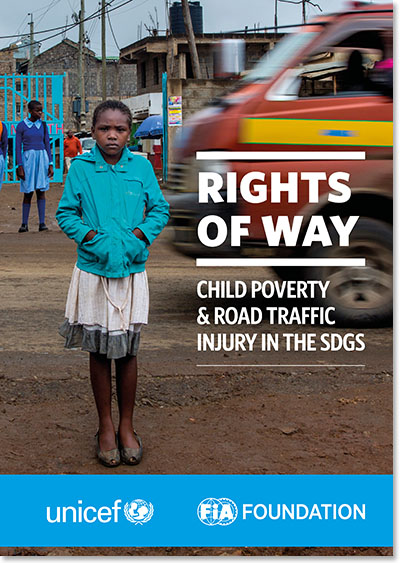
The Sustainable Development Goals and UN Habitat III herald a new era of global development, with the United Nations commitment to end poverty at their core. However, one significant contributor to poverty often goes unnoticed.
Although road traffic crashes kill 1.25 million people and injure 20-50 million more per year, and poor outdoor air quality caused approximately 3.7 million premature deaths globally in 2012 according to the WHO, the link to poverty is under-appreciated. Road crashes and air pollution strike the most vulnerable, leaving many behind. Ninety per cent of road crashes and 88% of premature deaths from poor outdoor air quality occur in low-and middle income countries.
Our poorest and most vulnerable are affected. We lose 500 children per day on our roads, often on their journey to school – striving for the very thing that will lift them, and their families, out of poverty.
Subjecting our children to dangers on roads, and therefore denying them health and education, violates the Convention on the Rights of the Child which commits governments to meet legal obligations including injury prevention and child health.
Partnership for change
This injustice does not have to occur. We have solutions, but need political commitment, funding, and global support to turn them into reality. In response, the FIA Foundation convened the Global Initiative on Child Health and Mobility. The initiative provides a platform for commitment and action to address road traffic injuries and fatalities as a sustainable development priority, with a core goal – a safe and healthy journey to and from school for every child by 2030. It promotes an agenda that governments should put transport and urban planning at their core to protect children, their health, and their rights.
Partners UNICEF, UNEP, Save the Children, ODI, WRI, and the FIA Foundation are supporting rights of the child in the following ways:
- Safe, accessible, low-carbon mobility to promote equity and combat poverty;
- Clean air and a healthy environment;
- The role of safe and health mobility in enabling the right to an education.
Promoting these rights helps achieve SDG targets 3.6, 3.9, 7.3, 11.2, 11.6, 11.7, and 13.
Beyond the statistics
UNICEF and the FIA Foundation released a report outlining priorities in a ‘child first’ agenda. The report, Rights of Way: Child Poverty & Road Traffic Injury in the SDGs, examines the impact of road traffic injuries on families living in poverty in low- and middle-income countries, and calls for a global policy response. Moving beyond the statistics, it puts a face to some of the nearly 3000 children killed or injured daily.
One story is that of Maria Martinez, a single mother of five in Mexico. Her children, Adrianna and Wendy, were hit by a drunk driver in an area with little enforcement, robbing Wendy of her ability to walk. Despite her two jobs, Maria struggles to pay rent. She lost one job because she had to spend time caring for her daughter, and risks losing the other job. Her inability to read or write makes it hard to get a job, and means she is devoted to her children’s education to lift her family out of poverty. However, Adrianna and Wendy have missed a significant amount of school and Maria worries they cannot finish their education and secure jobs.
Lessons learned and recommendations for the future
Stories like Maria’s are told all over the world, in every language. This initiative envisions a future where those stories are a thing of the past.
The report examines successful initiatives, reflected in its ‘children first’ agenda:
- Ensure safe routes to school for all children, with walkable pavements, safe crossings, and effective vehicle speed management;
- Ensure safe travel to school. Seatbelts and safety checks for school buses, seatbelts or appropriate child restraints in cars, helmets for motorcycle passengers;
- Improve safety for all road users on high risk roads, meeting at least 3 star (out of 5) safety performance as measured by the International Road Assessment Programme;
- Prioritise pedestrians and cyclists in urban planning, increasing investments in safe infrastructure for non-motorised transport to encourage active, low carbon, mobility;
- Deploy and encourage pedestrian-friendly vehicle design and safety technologies, such as Autonomous Emergency Braking, which can mitigate or even stop a crash;
- Encourage policies to reduce vehicle emissions and improve air quality such as reducing sulphur levels in fuel (below 50ppm); particulate filters on vehicles; and improved vehicle fuel economy in line with Global Fuel Economy Initiative targets.
The Global Initiative advances this policy agenda as an SDG partnership encompassing advocacy, research, and capacity building, and providing support and technical assistance to catalyze national coalition work. It prioritizes securing the financing and policy commitments to scale-up work on road traffic injuries and sustainable mobility, with the goal of a safe and healthy route to and from school for every child by 2030.
 Welcome to the United Nations
Welcome to the United Nations